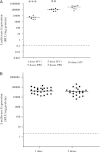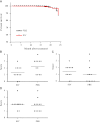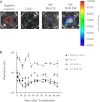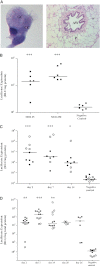Assessment of F/HN-pseudotyped lentivirus as a clinically relevant vector for lung gene therapy
- PMID: 22955314
- PMCID: PMC3530223
- DOI: 10.1164/rccm.201206-1056OC
Assessment of F/HN-pseudotyped lentivirus as a clinically relevant vector for lung gene therapy
Abstract
Rationale: Ongoing efforts to improve pulmonary gene transfer thereby enabling gene therapy for the treatment of lung diseases, such as cystic fibrosis (CF), has led to the assessment of a lentiviral vector (simian immunodeficiency virus [SIV]) pseudotyped with the Sendai virus envelope proteins F and HN.
Objectives: To place this vector onto a translational pathway to the clinic by addressing some key milestones that have to be achieved.
Methods: F/HN-SIV transduction efficiency, duration of expression, and toxicity were assessed in mice. In addition, F/HN-SIV was assessed in differentiated human air-liquid interface cultures, primary human nasal epithelial cells, and human and sheep lung slices.
Measurements and main results: A single dose produces lung expression for the lifetime of the mouse (~2 yr). Only brief contact time is needed to achieve transduction. Repeated daily administration leads to a dose-related increase in gene expression. Repeated monthly administration to mouse lower airways is feasible without loss of gene expression. There is no evidence of chronic toxicity during a 2-year study period. F/HN-SIV leads to persistent gene expression in human differentiated airway cultures and human lung slices and transduces freshly obtained primary human airway epithelial cells.
Conclusions: The data support F/HN-pseudotyped SIV as a promising vector for pulmonary gene therapy for several diseases including CF. We are now undertaking the necessary refinements to progress this vector into clinical trials.
Figures







Similar articles
-
Preparation for a first-in-man lentivirus trial in patients with cystic fibrosis.Thorax. 2017 Feb;72(2):137-147. doi: 10.1136/thoraxjnl-2016-208406. Epub 2016 Nov 16. Thorax. 2017. PMID: 27852956 Free PMC article.
-
Toward gene therapy for cystic fibrosis using a lentivirus pseudotyped with Sendai virus envelopes.Mol Ther. 2010 Jun;18(6):1173-82. doi: 10.1038/mt.2010.13. Epub 2010 Mar 23. Mol Ther. 2010. PMID: 20332767 Free PMC article.
-
Ex Vivo and In Vivo Lentivirus-Mediated Transduction of Airway Epithelial Progenitor Cells.Curr Gene Ther. 2015;15(6):581-90. doi: 10.2174/1566523215666151016123625. Curr Gene Ther. 2015. PMID: 26471068
-
Lentiviral Gene Therapy for Cystic Fibrosis: A Promising Approach and First-in-Human Trial.Am J Respir Crit Care Med. 2024 Dec 15;210(12):1398-1408. doi: 10.1164/rccm.202402-0389CI. Am J Respir Crit Care Med. 2024. PMID: 39236265 Free PMC article. Review.
-
Moving forward: cystic fibrosis gene therapy.Hum Mol Genet. 2013 Oct 15;22(R1):R52-8. doi: 10.1093/hmg/ddt372. Epub 2013 Aug 4. Hum Mol Genet. 2013. PMID: 23918661 Review.
Cited by
-
Lentiviral expression of wild-type LAMA3A restores cell adhesion in airway basal cells from children with epidermolysis bullosa.Mol Ther. 2024 May 1;32(5):1497-1509. doi: 10.1016/j.ymthe.2024.02.032. Epub 2024 Feb 29. Mol Ther. 2024. PMID: 38429928 Free PMC article.
-
Update in cystic fibrosis 2012.Am J Respir Crit Care Med. 2013 May 1;187(9):915-9. doi: 10.1164/rccm.201301-0184UP. Am J Respir Crit Care Med. 2013. PMID: 23634859 Free PMC article. Review. No abstract available.
-
Ferret and pig models of cystic fibrosis: prospects and promise for gene therapy.Hum Gene Ther Clin Dev. 2015 Mar;26(1):38-49. doi: 10.1089/humc.2014.154. Epub 2015 Feb 12. Hum Gene Ther Clin Dev. 2015. PMID: 25675143 Free PMC article. Review.
-
Lung-targeting lentiviral vector for passive immunisation against influenza.Thorax. 2020 Dec;75(12):1112-1115. doi: 10.1136/thoraxjnl-2020-214656. Epub 2020 Sep 3. Thorax. 2020. PMID: 32883885 Free PMC article.
-
Gene Therapy for Respiratory Diseases: Progress and a Changing Context.Hum Gene Ther. 2020 Sep;31(17-18):911-916. doi: 10.1089/hum.2020.142. Hum Gene Ther. 2020. PMID: 32746737 Free PMC article. No abstract available.
References
-
- Griesenbach U, Alton EW. Progress in gene and cell therapy for cystic fibrosis lung disease. Curr Pharm Des 2012;18:642–662 - PubMed
-
- Yonemitsu Y, Kitson C, Ferrari S, Farley R, Griesenbach U, Judd D, Steel R, Scheid P, Zhu J, Jeffery PK, et al. Efficient gene transfer to airway epithelium using recombinant Sendai virus. Nat Biotechnol 2000;18:970–973 - PubMed
-
- Griesenbach U, Cassady RL, Ferrari S, Fukumura M, Muller C, Schmitt E, Zhu J, Jeffery PK, Nagai Y, Geddes DM, et al. The nasal epithelium as a factory for systemic protein delivery. Mol Ther 2002;5:98–103 - PubMed
-
- Sumner-Jones SG, Davies LA, Varathalingam A, Gill DR, Hyde SC. Long-term persistence of gene expression from adeno-associated virus serotype 5 in the mouse airways. Gene Ther 2006;13:1703–1713 - PubMed
Publication types
MeSH terms
Grants and funding
LinkOut - more resources
Full Text Sources
Other Literature Sources
Medical

